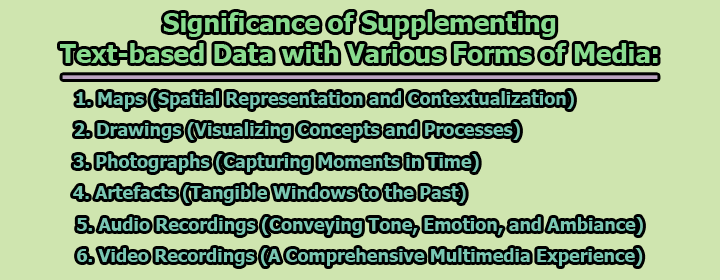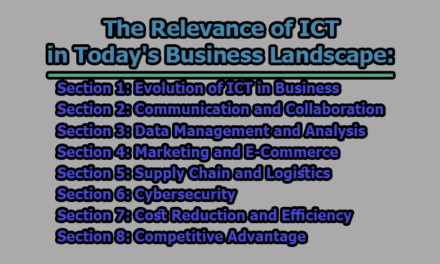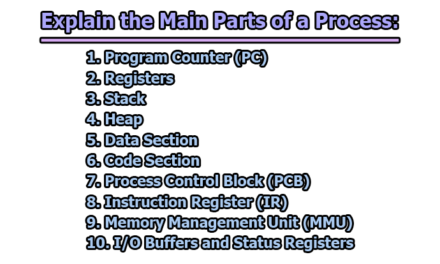Significance of Supplementing Text-based Data with Various Forms of Media:
In the realm of information and communication, text-based data has long been a fundamental pillar, serving as a primary means of conveying knowledge, ideas, and narratives. However, the richness of human experience extends far beyond the confines of written words. To capture the complexity and depth of information, text-based data can be significantly augmented by incorporating diverse media such as maps, drawings, photographs, artefacts, audio recordings, and video recordings. This multifaceted integration not only enhances the comprehensiveness of data but also provides a more immersive and engaging experience for users. In this article, we will explore the significance of supplementing text-based data with various forms of media and examines how this approach can unlock new dimensions of understanding.
1. Maps (Spatial Representation and Contextualization): Maps are powerful tools for representing spatial information, offering a visual context that text alone often struggles to provide. Whether illustrating geographical locations, topography, or distribution patterns, maps enable a more intuitive grasp of spatial relationships. In educational materials, research papers, or even storytelling, incorporating maps can enhance the audience’s comprehension by placing information within a tangible, visual framework. For instance, in historical narratives, maps can elucidate the progression of events, showcasing the movement of armies, trade routes, or the expansion of civilizations.
2. Drawings (Visualizing Concepts and Processes): Drawings and diagrams offer a unique way to visualize abstract concepts and intricate processes that may be challenging to articulate through text alone. Scientific research, architectural plans, and instructional manuals often benefit from the inclusion of drawings. By simplifying complex ideas into visual representations, drawings facilitate clearer communication and understanding. Furthermore, in creative fields like literature, visualizing characters, settings, or scenes through drawings can evoke a more vivid and personalized experience for the audience.
3. Photographs (Capturing Moments in Time): Photographs have the unparalleled ability to freeze moments in time, preserving the nuances and emotions that words may struggle to convey. Incorporating photographs into text-based data adds a layer of authenticity and immediacy, connecting the audience with the subject matter on a more visceral level. In journalism, historical documentation, or personal narratives, photographs serve as powerful supplements, allowing readers to witness events, places, and people as they truly existed.
4. Artefacts (Tangible Windows to the Past): Artefacts, tangible objects from the past, provide a direct link to history and culture. Integrating artefacts into text-based data offers a tangible connection to the subject matter, allowing users to engage with the past in a more intimate manner. In museums, educational resources, or historical analyses, artefacts provide a sensory experience that transcends the limitations of text. They offer a glimpse into material culture, shedding light on societal practices, technological advancements, and artistic expressions.
5. Audio Recordings (Conveying Tone, Emotion, and Ambiance): Text alone often struggles to convey the subtleties of tone, emotion, and ambiance inherent in spoken communication. Audio recordings, whether capturing interviews, speeches, or ambient sounds, add a layer of depth to text-based data. In fields such as journalism, oral history, or language learning, incorporating audio enriches the user experience by providing an authentic and immersive encounter with the subject matter. It also helps convey nuances that may be lost in written transcripts.
6. Video Recordings (A Comprehensive Multimedia Experience): Video recordings represent a culmination of various media, combining visual, auditory, and sometimes textual elements to deliver a comprehensive and dynamic user experience. From documentaries and tutorials to virtual tours and storytelling, video recordings offer a versatile medium for conveying information. The inclusion of video enhances engagement, allowing users to see and hear the subject matter in action, fostering a deeper understanding and connection.
Benefits of Multifaceted Integration:
The integration of maps, drawings, photographs, artefacts, audio recordings, and video recordings with text-based data yields several significant benefits.
- Enhanced Understanding: By appealing to different learning styles, multimedia integration ensures that information is accessible to a broader audience. Visual learners, for example, may benefit greatly from maps, drawings, and photographs, while auditory learners may prefer audio recordings. This inclusivity promotes a more thorough understanding of the content.
- Increased Engagement: Multimedia content is inherently more engaging than text alone. The combination of visual and auditory elements captures the audience’s attention and sustains their interest, resulting in a more immersive learning or informational experience. This is particularly crucial in the digital age, where attention spans are often fleeting.
- Improved Retention: Research suggests that the integration of multimedia elements can enhance information retention. The combination of textual and visual or auditory stimuli creates multiple points of entry for the brain, reinforcing the learning experience and making it more likely that the information will be retained over time.
- Real-world Context: Maps, photographs, artefacts, and videos provide real-world context, grounding abstract concepts in tangible examples. This connection to reality fosters a deeper appreciation for the subject matter, whether it be historical events, scientific processes, or cultural phenomena.
- Effective Communication: Different forms of media cater to different modes of communication. While text may be ideal for conveying detailed information, maps and diagrams excel in illustrating relationships and spatial concepts. Audio recordings and videos, on the other hand, excel in capturing the nuances of human communication. Employing a combination of these mediums allows for more effective and nuanced communication.
Challenges and Considerations:
While the integration of diverse media with text-based data offers numerous advantages, it is essential to acknowledge and address potential challenges and considerations.
- Accessibility: Not all individuals have equal access to multimedia content. In some cases, users with visual or auditory impairments may face barriers when engaging with certain types of media. To ensure inclusivity, content creators must prioritize accessibility features, such as alternative text for images, subtitles for videos, and transcripts for audio recordings.
- Overwhelming Complexity: While multimedia integration enhances comprehensiveness, there is a risk of overwhelming users with excessive information. Striking a balance between providing rich content and preventing cognitive overload is crucial to maintaining an effective and enjoyable learning experience.
- Technological Infrastructure: Effective integration of multimedia often relies on robust technological infrastructure. High-quality images, videos, and audio recordings demand sufficient storage capacity and bandwidth. In some contexts, particularly in developing regions, limited technological resources may hinder the seamless integration of multimedia elements.
In conclusion, in the evolving landscape of information dissemination, the integration of maps, drawings, photographs, artefacts, audio recordings, and video recordings with text-based data represents a powerful approach to enriching communication and understanding. This multifaceted integration not only addresses the limitations of text alone but also caters to diverse learning styles, enhances engagement, and fosters a more profound connection between users and the subject matter. However, it is crucial to navigate challenges such as accessibility and the potential for overwhelming complexity to ensure that the benefits of multimedia integration are realized by a broad and inclusive audience. Ultimately, the synergy of text and diverse media forms a dynamic tapestry that reflects the multifaceted nature of human experience and knowledge.

Library Lecturer at Nurul Amin Degree College










